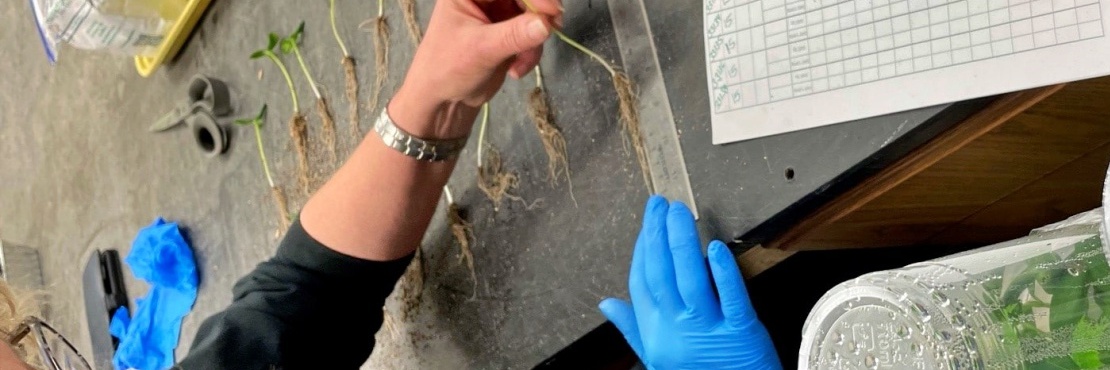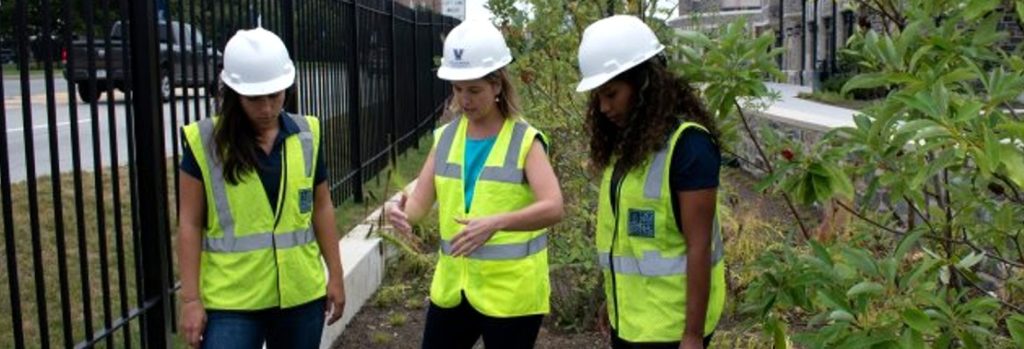What Role Does Compost Play in Green Infrastructure?
Green infrastructure is a comprehensive term used primarily to describe natural solutions to stormwater management. Green infrastructure may include green roofs, bioretention soils, rain gardens, or compost blankets used for erosion control and slope stabilization. A key component for success of all these applications is the use of compost, whether used directly or used indirectly as a component of a soil or green roof media blend.
With increasing adoption of green infrastructure to solve stormwater challenges, sourcing the most appropriate high-quality compost for each purpose is more important than ever. The good news is that there are nationwide standards that can benefit any green infrastructure project: the Test Methods for the Evaluation of Compost & Composting and the United States Composting Council’s Seal of Testing Assurance Program.
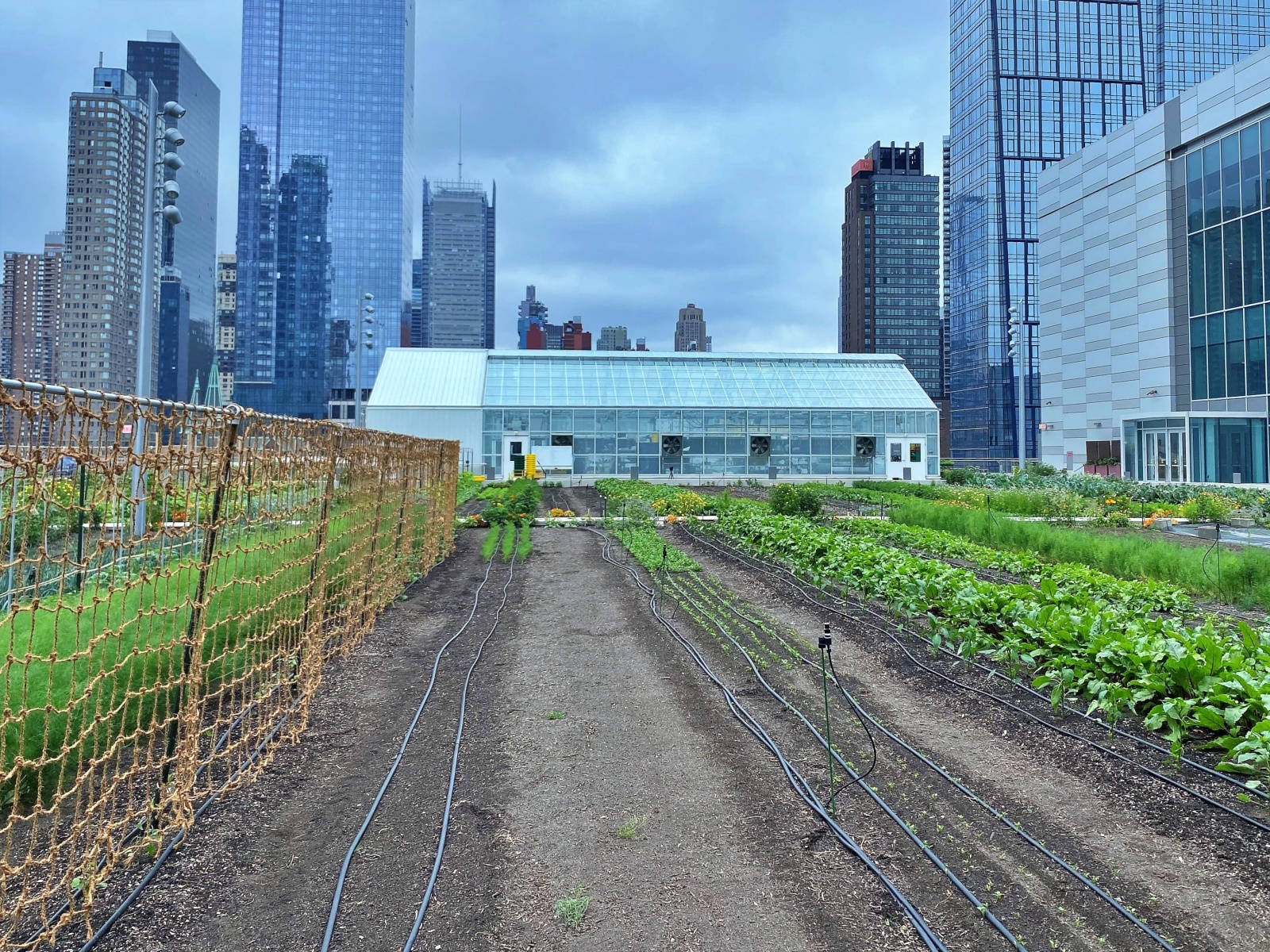
Naturcycle green roof media has been used for urban agriculture in the Javits Center Rooftop Farm in Manhattan, NY. Image: Naturcycle
Development of the TMECC & Benefits of the STA Program
The United States Composting Council (USCC) started in the early 1990’s as an industry group composed of compost producers, technology providers, equipment manufacturers, municipal entities, and research scientists. These stakeholders came together to improve composting processes, promote compost uses, and market compost products.
The USCC and the non-profit Compost Research & Education Foundation (CREF) worked closely with the Environmental Protection Agency (EPA) and the U.S. Department of Agriculture (USDA) to develop the Test Methods for the Evaluation of Compost & Composting (TMECC) after reviewing decades of existing research. Structured similarly to the commonly used American Society of Testing & Materials (ASTM) standards, the TMECC provides a laboratory manual for all the testing methods related to the evaluation of compost. Specifications based on these universal standards can be used from New York to Texas, supporting green infrastructure applications nationwide.
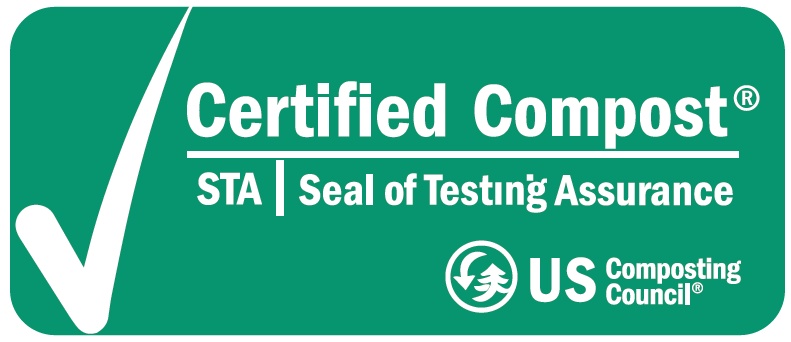
The TMECC is the foundation for the USCC’s Seal of Testing Assurance (STA) Program. Hundreds of compost producers throughout the United States have enrolled their compost in this program, which requires testing on a regular basis from one of thirteen independent laboratories. This means that every participating compost producer will have up-to-date analysis of their compost using the TMECC methods for a diversity of significant characteristics, including plant nutrients, moisture content, organic matter, pH, soluble salts, particle size, stability, maturity, select pathogens, and trace metals.
When a firm like Naturcycle designs a soil blend or green roof media, compost analysis from the STA program can help determine which available compost is most appropriate for the application. Thanks to the TMECC standards and the STA program, recent standardized compost analysis is available for the landscape architect, engineer, or project manager on a green infrastructure installation to evaluate, eliminating the uncertainty of comparing compost tested using differing methods.
How the CAP Program Ensures High Quality Compost Analysis
Because laboratories that analyze compost as part of the STA program must meet certain standards and use the same universal test methods, a key component of the STA program is the Compost Analysis Proficiency (CAP) Program, which analyzes the efficacy of participating laboratories. The CAP program is overseen by Dr. Robert Miller of Colorado State University and supported via STA program fees. Dr. Miller is an expert in laboratory compliance, administering several such programs.
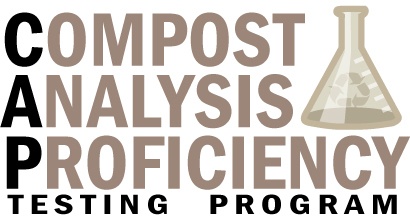
To ensure confidence that analysis from a lab in California will produce the same results as a lab in Pennsylvania, the CAP program regularly conducts quality control testing. Samples of the same compost will be sent to several different labs for assessment. The resulting test reports are provided to Dr. Miller for statistical analysis and review. The results must be consistent and fall within a certain allowable variance to remain certified in the STA program. With the knowledge that all certified labs nationwide will perform the same high-caliber evaluation and present essential compost characteristics in the same format, direct comparison of compost products is achievable.
No other soil amendment has the level of technical oversight, security, and quality assurance as STA certified compost. Because the CAP program confirms that certified labs maintain high standards of quality, if a landscape architect or engineer specifies STA compost for a project, there is confidence that the submitted material will be regularly tested and meet all STA program criteria. Compost plays a fundamental role in green infrastructure installations and thanks to the hard work being done behind the scenes by Dr. Miller and the CAP program, projects using STA compost will continue to produce successful outcomes.
Interpreting STA Data with a Compost Technical Data Sheet
Whether it is used in green roof media, erosion control blankets or wetland recovery, compost is a critical tool for stormwater management and restoring natural ecosystems. To use compost appropriately for a given application, it is vital to interpret STA data correctly.
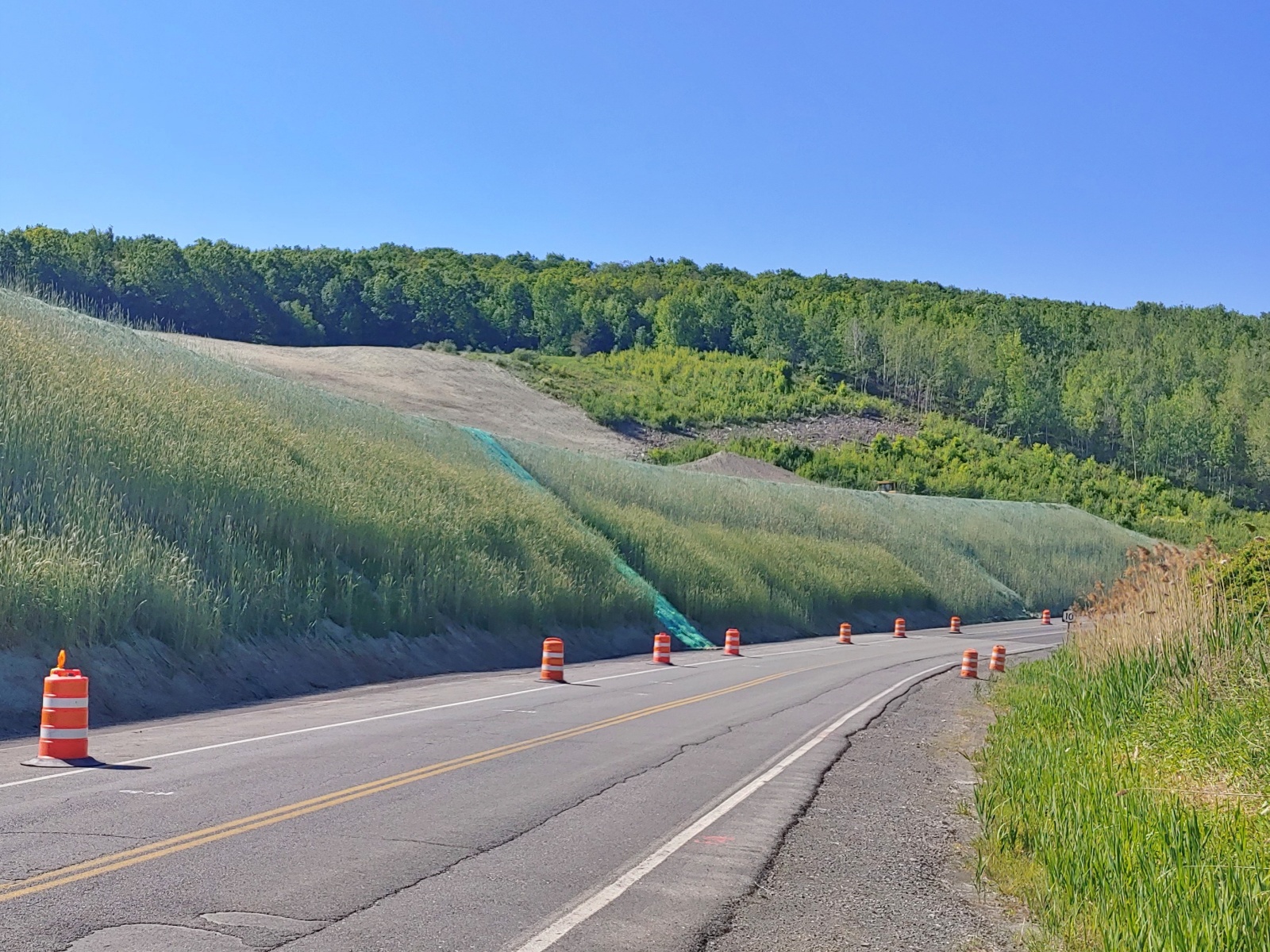
A compost blanket was used to stabilize this slope and control erosion along a highway in New York’s Mohawk Valley. Image: Naturcycle
For every compost sample submitted to a testing laboratory through the STA program, a participating compost producer receives two reports: a comprehensive analysis of all parameters tested, plus a Compost Technical Data Sheet (CTDS). Because the CTDS formats the compost data in the same way regardless of the laboratory that conducted the analysis, a compost user can directly compare either two different composts or the same compost at different points in time, using a simple, one-page report.
While anyone can have compost tested to STA standards, only STA participants can receive a CTDS.
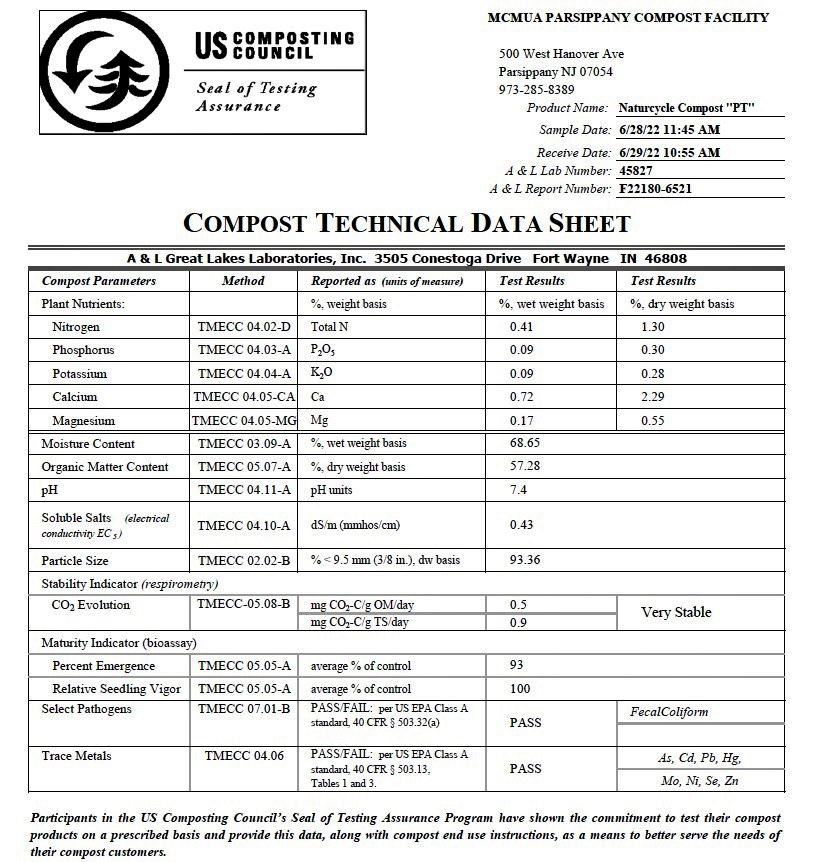
The data starts in the top right of the page, with the name and location of the compost facility, plus the Product I.D., which is the brand name of the compost. Next are the dates the compost was sampled from the site and received by the laboratory, followed by information about the laboratory, including the lab name, number, and address, as well as the associated report number for the completed analysis. Finally, the results of the compost testing are presented, along with the standardized methods and units of measure.
Plant Nutrients
Nitrogen, phosphorous, potassium, calcium, and magnesium, often referred to as macronutrients, are critical elements for plant growth. Their concentration in a compost product is used to calculate application rates for agronomic purposes. Unlike chemical fertilizer, using compost as a soil amendment provides organic forms of these nutrients rather than a manufactured form, so the nutrients are released to plants more slowly, over a longer period. The wet weight basis refers to the concentration of nutrients in the compost as it was received by the lab, with whatever naturally occurring moisture that is present, while the dry weight basis is based on a calculation that removes the water weight of the sample. (Some states do not allow producers to indicate the nutrient content of their compost, so the CTDS includes a second page that omits this information but is otherwise identical.)
Moisture Content
Moisture content refers to the percentage of the sample weight that is made up of water at the time of testing. This number can vary seasonally or due to material handling. A moisture content of 30% to 55% is common for most compost types, but values slightly outside this range would not impact most uses. Consistent moisture content over 65% indicates a lower quality compost product and a flawed manufacturing process.
Organic Matter Content
Organic matter content is a measure of the naturally occurring carbon compounds in a compost sample and is expressed as a percentage of total mass. A critical component for soil amendment, organic matter improves soil health and supports plant growth. Organic matter content for a high-quality compost falls into an optimal range of 30% to 60%. Findings in the 15% to 30% range may indicate an older compost where much of the organic matter has been mineralized, resulting in a less effective soil amendment, while a result over 60% indicates potential for soil compaction as organic matter is mineralized.
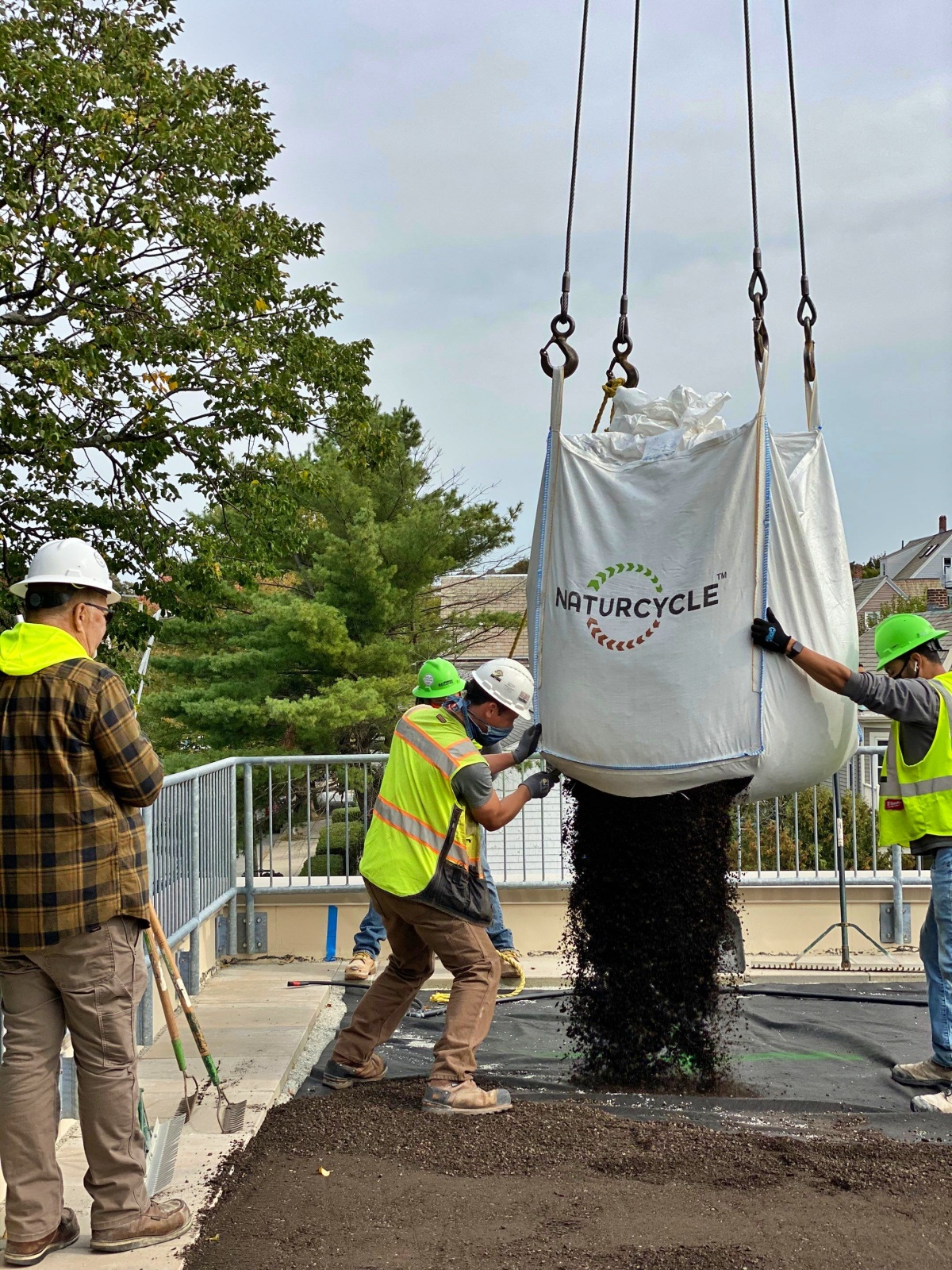
The award-winning green roof on a former school in Somerville, MA utilized green roof media supplied by Naturcycle. Image: Naturcycle
pH
pH is a measure of free hydrogen ions, which assists the nutrient uptake in plants. A range of 6 to 8 is a good pH target for a wide assortment of compost applications. Finished and stabilized compost is often slightly alkaline, with a pH over 7, particularly in the northeastern United States where deciduous leaves make up a substantial portion of compost feedstocks. Ultimately, local environmental conditions play a much larger role in determining the pH of a soil than the pH of the compost used to amend it.
Soluble Salts
The concentration of soluble salts in a compost sample is a measure of electrical conductivity resulting from dissolved inorganic solutes. Common soluble salts include calcium, magnesium, chloride, sulfate, and smaller quantities of ammonium nitrate or other potential plant nutrients. As part of the STA methodology, soluble salts are measured by using distilled water to dilute compost media at a 5:1 ratio. While an optimal range between 0.5 to 2.0 dS/m (or mmhos) can be considered, this measure can fluctuate widely. Some soluble salts are harmful to plants while other are beneficial, so further examination may be needed on a compost with higher readings. Composts with low levels of soluble salts can be beneficial for certain uses, but composts with zero soluble salts indicate that there are few or no available plant nutrients.
Particle Size
This parameter is a physical measure of the compost, where the material is passed through several sieves that range in size. The CTDS reports the portion of compost that passes the 3/8” inch sieve (9.5 millimeters), while the complete STA Compost Analysis reports more detailed results using a range of different sized sieves. Particle size is an important consideration for compost used in green infrastructure applications, especially for erosion control projects where a coarser compost is more desirable.
Compost Stability
In the STA program, CO2 evolution is a measure of compost stability. The TMECC standard methodology calls for testing this parameter via respirometry, which measures the metabolic rate of the active biology in the compost and assigns a Stability Rating. In this case, lower numerical values are better, with a result at or below 2.0 being considered a stable or very stable compost. A result over 2.0 suggests that the tested material may still be actively composting and is therefore considered unstable. (See table below from the Agricultural Analytical Services Laboratory at The Pennsylvania State University.)
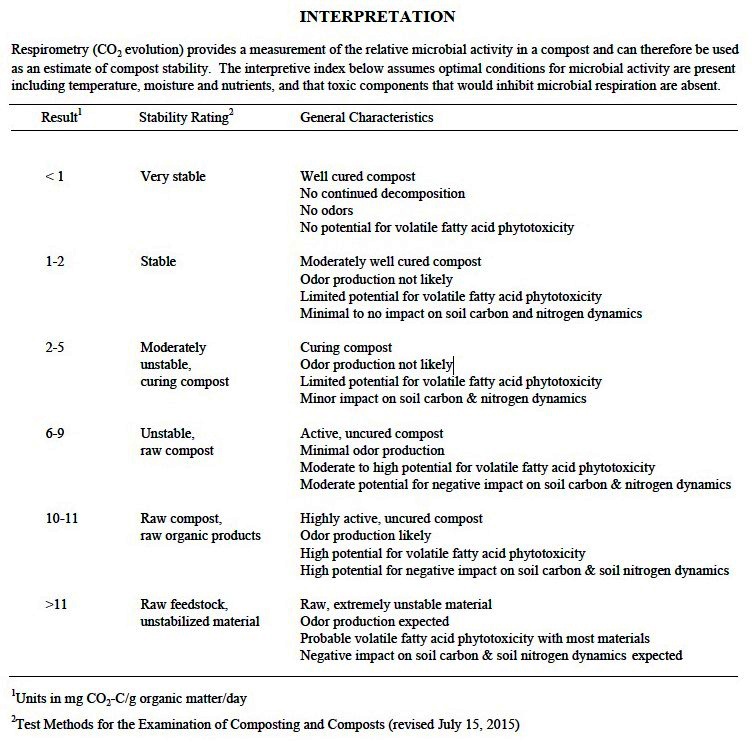
Image: Agricultural Analytical Services Laboratory at The Pennsylvania State University
Compost Maturity
The STA program requires a bioassay to be performed using submitted compost samples. This is a unique test that measures the compost by its effect on living cells or tissues, in this case, cucumber seedlings, which are relatively easy to grow and have a well-defined leaf structure useful for comparison. Conducted in a growth chamber controlled for temperature, moisture, and light, the compost is diluted 50/50 with vermiculite and compared to a high-quality potting mix used as a control. While this dilution has a higher concentration of compost than a typical compost use, it serves to accentuate the effects of the compost in this experimental setup.
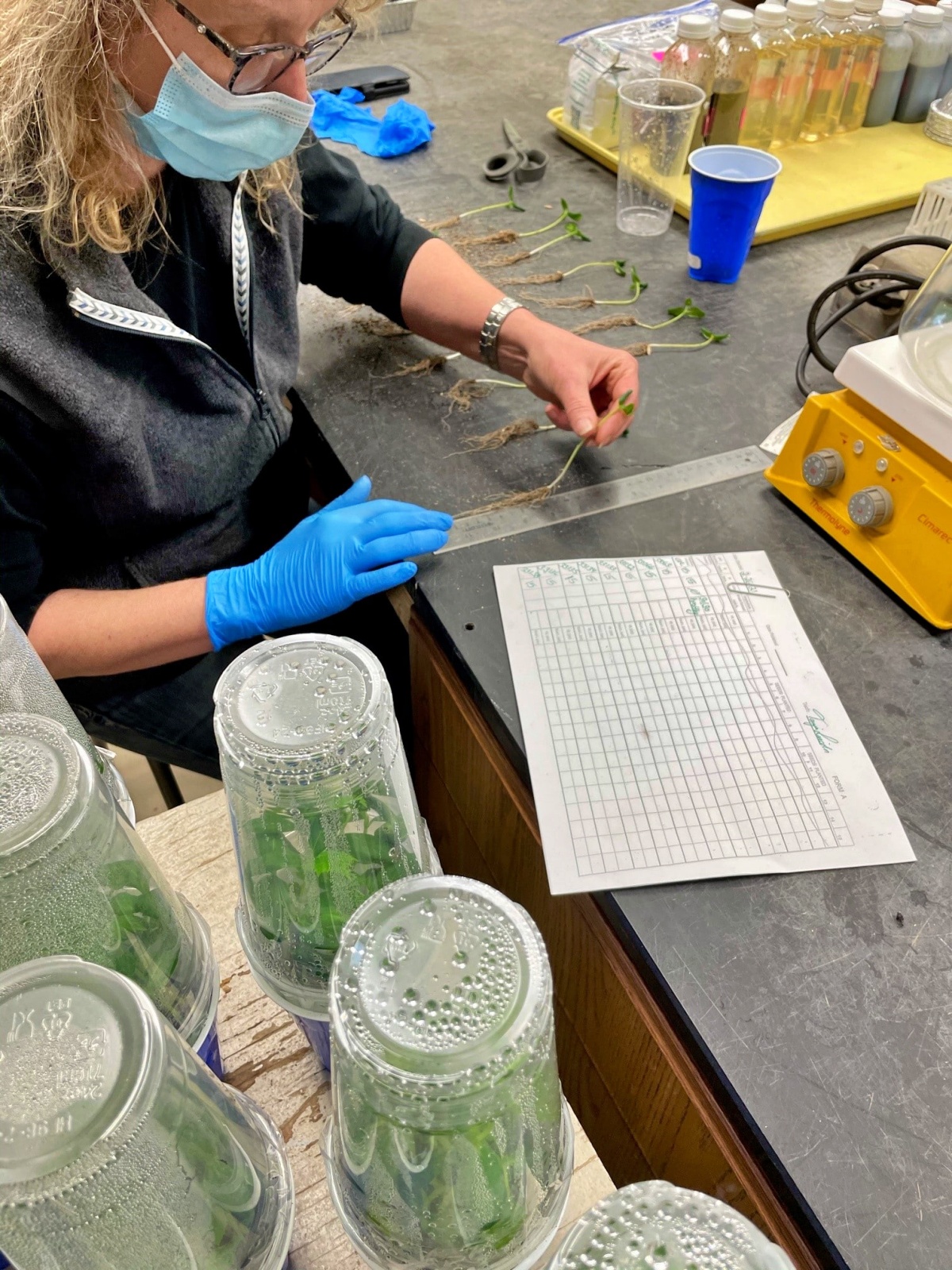
The lab at A&L Great Lakes conducts bioassay testing by comparing plants grown in compost samples to a control blend. Image: Naturcycle
Percent emergence measures the number of cucumber seeds that germinate in the compost sample compared to the control sample using the same seeds. A result above 80% is considered mature. Relative seedling vigor is a visual comparison of the physical structure and appearance seedlings grown in compost to those grown in the control media. The plants growing in compost must be taller and have larger leaves to achieve a higher percentage result. This test is one of the most useful, where phytotoxic effects can be observed, such as curled leaves or underdevelopment. These combined tests provide a great deal of information for compost producers and end users.
Select Pathogens
The STA program requires participating compost producers to test for the presence of either fecal coliform or salmonella, two common pathogens that the EPA considers to be primary indicators for human health and safety. This parameter is measured using the Most Probable Number (MPN) index, which is defined as:
“An index of the number of bacteria that more probably than any other number would give the results shown by laboratory examination, the results of which are not an actual enumeration but are taken from standardized probability tables.”
Like the EPA regulatory limits for biosolids, the STA considers 1,000 MPN to be the limit for compost. Samples exceeding this value are deemed to fail pathogen testing while samples with a MPN below this value are deemed to pass pathogen testing. It is worth noting that naturally occurring background levels of these pathogens in soils is many times higher than the standard for compost. When completed correctly, the composting process reduces pathogens, so using this indicator confirms that the compost was produced properly and the likelihood of dangerous pathogens being present in a compost is extremely low, if not eliminated.
Trace Metals
Another special requirement of the STA program is regular testing for the presence of heavy metals that can impact human health. Once again basing the standards on the EPA regulatory limits for biosolids, the STA program sets a maximum allowable concentration of heavy metals that can appear in compost on an average annual basis. All heavy metals measured must fall below these limits for a compost to pass heavy metals testing. If any one of the metals tested exceeds their specified limit, the compost sample fails. A typical compost will have heavy metals well below these limits and may not even appear in detectable amounts at all.
End Use Instructions
Since the STA is both a testing program and a disclosure program, every participant is required to provide end use instructions and list the ingredients used to make their compost, emphasized by the notation at the bottom of the CTDS. As an STA participant, Naturcycle provides end use instruction for every compost that we market as well as guidance on application rates.
The Future of Green Infrastructure Depends on Compost
With compost data standardized through the STA program and accessible via a CTDS, engineers and landscape architects can easily find the right compost for a variety of applications. For example, a finished stable compost with a neutral pH that is low in nutrients would be a good match for a bio-retention blend, while a coarser compost with a larger particle size and higher organic matter content would be best for an erosion control blanket, and an acidic compost with a finer texture is ideal for topdressing an athletic field. It is necessary to work with these construction industry professionals to source the correct compost for their projects.
Compost is not one-size-fits-all!
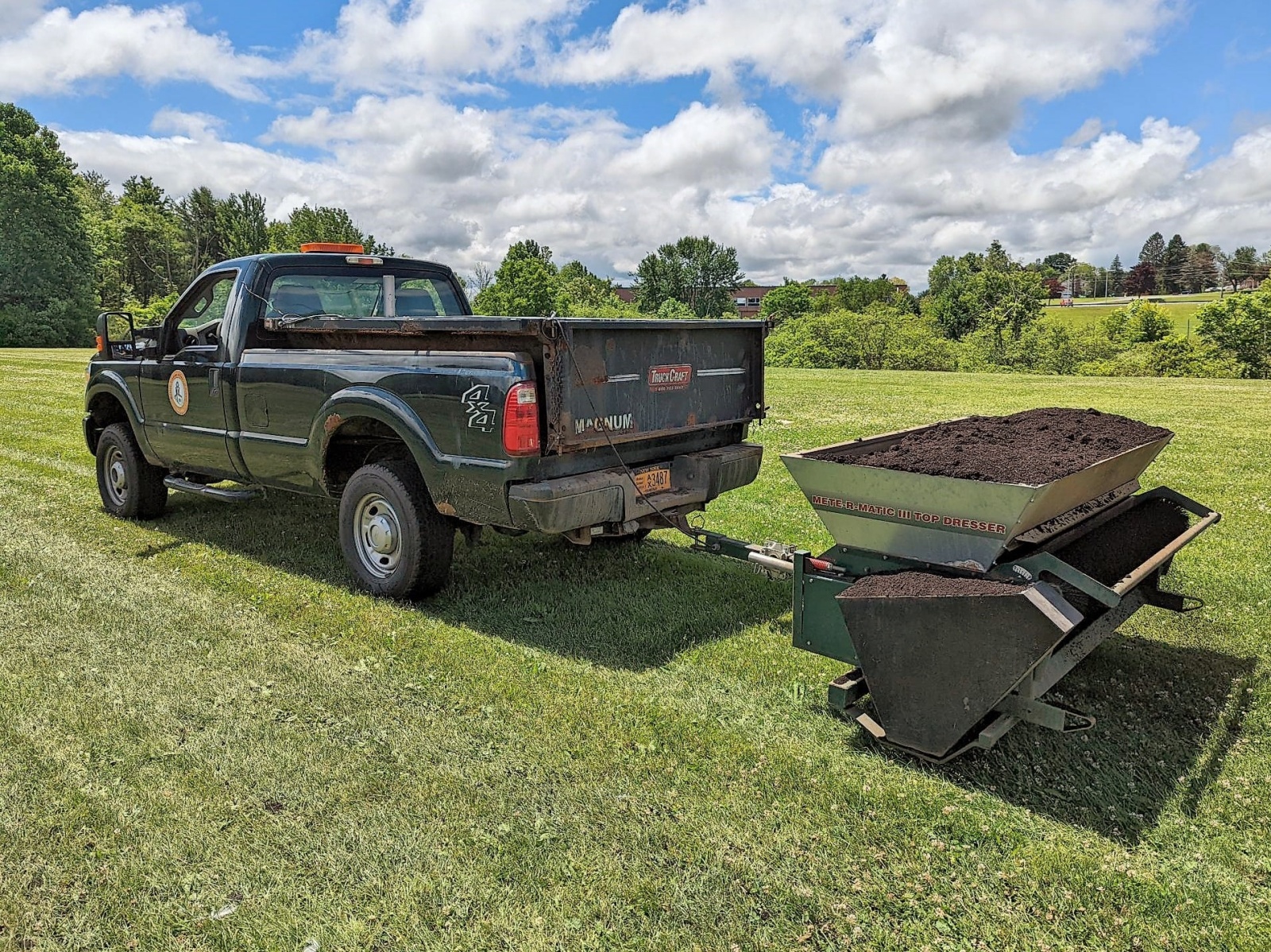
High quality composts with finer textures are excellent for use as topdressing for application on turf and athletic fields. Image: Naturcycle
Compost can be used in green infrastructure both directly and indirectly. Direct compost uses may require a specification, which is a set of parameters that a compost must meet to be used on a given project, using the TMECC methods and well-researched allowable ranges for essential compost characteristics. For indirect uses, such as green roof media where compost is used as one element in a blended product, it is recommended to require STA certified compost as the only acceptable organic component which ensures that data from recent laboratory analysis is available. When building a specification, it is crucial to remember to include the desired range, reported units, and test method for each parameter so that the design can be replicated.
The nationwide guidelines for compost provided by TMECC and the STA program provide the basis for increasing compost use and expanding markets. More than half of all states use STA compost as the standard of design. Landscape architects and engineers across the country specify STA compost. The US Composting Council continually updates a publicly available list of STA certified compost products from enrolled participants. The rigorous, continually monitored STA program provides the strong foundation for a growing green infrastructure industry and continued recognition of compost as a versatile solution for stormwater management challenges.
~ Charles Duprey

Charles Duprey is the founder and president of Naturcycle LLC. Drawing from his extensive personal experience and knowledge of the industry, his firm is focused on the sales and marketing of compost, engineered soils, and green roof media. Working with a variety of private and public entities, Naturcycle provides locally sourced material for landscapers, construction projects, and retail use throughout the northeastern United States, as well as consulting on the beneficial reuse of organics, engineered soil applications, and stormwater management projects all around the country.
Charles is an expert in green roof media design and manufacturing, with over fifteen years of experience developing and supplying some of the largest green roof and engineered soil projects in the Northeast, including the one-acre farm on the Javits Convention Center rooftop, green roofs from the Statue of Liberty Museum to the Boston Medical Center, and more. As a certified educator, he conducts professional development sessions on green infrastructure and sustainability for members of the American Society of Landscape Architects and has presented at conferences for the New York Solid Waste Association and the Water Environment Federation, among others.
Charles currently serves as a trustee for the Compost Research & Education Foundation. He is the former Vice Chair of the Market Development Committee of the United States Composting Council and is the co-chair of the USCC Seal of Testing Assurance Advisory Committee. He serves on many industry committees and has published several educational articles on a variety of related topics. He has both a B.S. and a B.A. from Syracuse University and resides in Central New York.
 Greenroofs.comConnecting the Planet + Living Architecture
Greenroofs.comConnecting the Planet + Living Architecture
